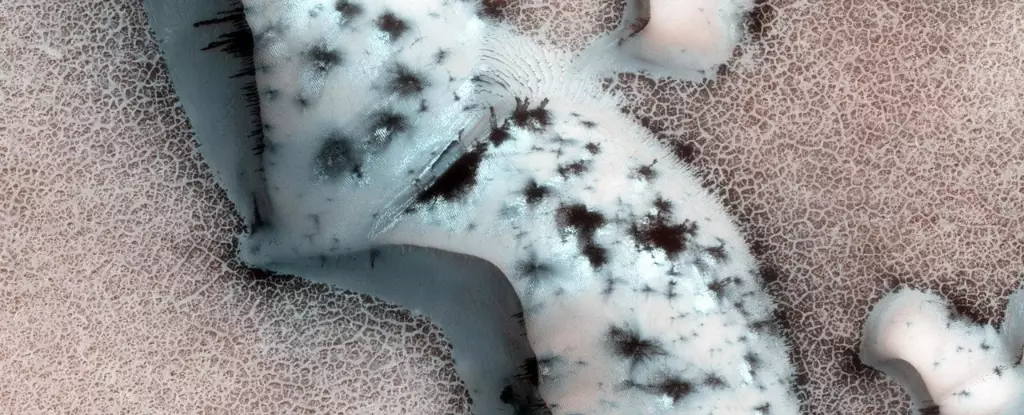Mars, often referred to as the “Red Planet,” has long fascinated scientists and enthusiasts alike. While it may seem like an uninhabitable world, barren and devoid of life, an underlying beauty emerges from its harsh and frigid environment. The stark landscapes of Mars unveil a tapestry of geological phenomena that offer a glimpse into processes far removed from those we experience on Earth. Central to this captivating story is the intriguing behavior of carbon dioxide (CO2) and its striking visual manifestations across the Martian surface.
At first glance, Mars might appear to be a dead planet. Its thin atmosphere—composed predominantly of carbon dioxide, to the tune of nearly 95%—presents a significant barrier to life as we know it. However, this atmosphere interacts dynamically with the planet’s climatic cycles, giving rise to extraordinary events. During the Martian winter, carbon dioxide freezes and blankets the polar regions in a thick frost. This dormant phase lasts for months, only to be challenged by the arrival of spring. As temperatures gradually rise, sunlight penetrates this translucent layer of frozen gas, warming the surface beneath.
This warming process sets the stage for one of Mars’ most mesmerizing phenomena—the sublimation of CO2. As temperatures increase, the solid CO2 transforms directly into a gas, creating immense pressure buildup underneath the ice layers. This pressure is not merely a static occurrence; it leads to explosive events that unfold across the Martian landscape.
In a spectacular display reminiscent of Earth’s geysers, Martin geysers release bursts of CO2 vapor that escape through weak points in the ice. These eruptions, observed in high-resolution imagery captured by the HiRISE camera aboard NASA’s Mars Reconnaissance Orbiter, showcase jets of gas that can reach speeds of up to 160 km/h. Some eruptions are powerful enough to unearth patches of dark material spreading across the polar ice, painting a vivid picture against the stark white backdrop of frozen CO2.
Interestingly, these phenomena have led to what scientists have delineated as “araneiform terrain,” or “spider terrain,” due to the intricate patterns and dark spots that emerge, resembling spiders on the Martian surface. The clusters of these features create a visually compelling aspect of Mars’ geography, highlighting a critical distinction between the natural processes occurring on Earth and those on Mars.
Researchers, including a team led by scientist Lauren McKeown from NASA’s Jet Propulsion Laboratory, have dedicated significant efforts to uncover the mysteries behind these formations. Laboratory recreations of the processes have helped elucidate how the CO2 cycle contributes to this unique geology. The Keiffer model—named after scientist Kenneth Keiffer—proposes that the seasonal ice cap forms a robust barrier that traps pressure beneath. Once the pressure becomes sufficient, it ruptures the ice, leading to eruptions that propel sand-sized particles into the air, crystallizing into the intriguing spider-like shapes displayed on the Martian surface.
The complexity of these processes lends credence to the idea that Mars possesses a unique charm derived from its geological activity. While poets and artists have historically celebrated the beauty of our own blue planet, the emergence of these otherworldly patterns on Mars invites new forms of admiration and curiosity.
In contemplating the beauty of Mars, one might argue that beauty is not merely a product of lush landscapes and vibrant ecosystems, but also the result of the profound processes that shape a world. Mars, with its CO2 geysers and spider terrain, offers a distinctive perspective on what constitutes beauty in the cosmos. While it may not match the lushness of Earth, it presents a different kind of splendor—one characterized by eerie tranquility and evidence of dynamic geological activity.
As humanity explores the cosmos further, our understanding of beauty evolves, urging us to gaze beyond the familiar comforts of Earth. The interplay between elements, temperature, and pressure unravels a vision of an enduring dance of nature, reminding us that even in the vast emptiness of space, beauty manifests in the most unexpected ways.


Leave a Reply